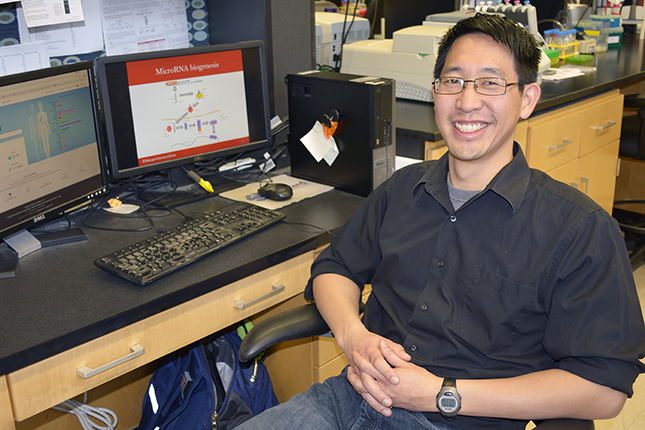
Tell me about your background.
I was born in Chicago and grew up in Scottsdale, a suburb of Phoenix, AZ. I went to Arizona State University in Tempe (another Phoenix suburb) for my Bachelor’s and Master’s in Biomedical Engineering (BME). After that, I came here to Washington University to pursue my PhD in BME.
What led you to study at Washington University?
When I was looking for BME programs, I wanted to get involved in translational medicine. This meant that the program needed to be connected to a strong medical center, and have a healthy relationship with physicians who would be willing to collaborate on research leading to better treatments. After interviewing at Washington University, I was convinced that the research fed into improved treatments and vice versa. On a more personal note, everyone that I talked to during the interview process, both students and professors, was friendly and easy to get along with, and they also laid out what sort of vision they had for their individual research goals.
What are your future career goals/plans?
I would like to continue on with bioinformatics research from the industry side. I feel that there is a need for both strong academic research and strong industrial research in medicine, and I am ready to contribute to the other branch.
Tell me about your thesis research.
MicroRNAs (miRNAs) are short non-coding RNA sequences that regulate protein production by targeting and degrading messenger RNA transcripts. The expression levels of miRNAs change based on cell and organism development stages, and can also be indicators of disease. This has been observed in cancer, and miRNAs can be used as biomarkers to determine both likelihood of cancer formation, as well as risk of patient death after diagnosis and treatment. Other biomarkers include human papillomavirus (HPV) infection, which is the primary cause of cervical cancer and responsible for an increase in oropharyngeal cancers. Identification of miRNA biomarkers requires large sequencing datasets, which we found in The Cancer Genome Atlas (TCGA). By combining miRNA and RNA sequencing analysis, we identified miRNAs that were significantly upregulated and downregulated between living and deceased patients in TCGA, and combined them into signatures that identify high and low risk patients independently of HPV status.
We also decided to apply the biomarker identification pipeline across as many cancer types as we could in TCGA. In doing so, we created a database of significant miRNAs associated with diagnostic staging, tumor formation, and cancer survival. We were also able to integrate miRNA-target prediction on the basis of cancer types, and provide all of the results of our analysis into a database. We also built a web server that can analyze custom miRNA-expression survival signatures, and perform clustering analysis on mean miRNA expression. The database and these tools are publicly web accessible at www.oncomir.org
Was there something in particular that led you to this subject of research?
My parents are both medical professionals (hi, Mom and Dad!), and I wanted to be able to perform research that could contribute directly to the clinic. One way to do that is though improving diagnostic criteria. When I met with Dr. Xiaowei Wang, he was showing how some of his research could identify patients with better or worse outcome and why that was important for deciding the best course of treatment. After that, I started thinking that diagnostic tools were just as important as drug development, and our contributions to the clinical environment were just as valuable.
What are your future plans for this subject?
We’ve already started working on the next stage of this research, which is to identify some of the biological mechanisms underlying our biomarker findings. More specifically, we hypothesize that as a regulatory body, miRNAs can help us understand why HPV can lead to tumor formation, but also help improve patient survival. By identifying miRNA-target interactions specific to HPV infection, tumor formation, and tumor survival, we have started analyzing biological pathways and processes that can explain this unique dichotomy of HPV as a biomarker.
What has been the most challenging aspect of your research/thesis?
Asides from the general aches, pains, groans, and occasional mutterings associated with research, my work has been extremely rewarding and productive. The biggest challenge has come from balancing work and home, especially when it comes to making sure I don’t miss out on watching my two children grow up. Richard and Adelaide were both born during my time here at Washington University, and, as Dr. Wang recently mentioned to me, in practice, they’ve each been as much as work as a new journal article. For that, I have my awesome wife Amy to thank, because she’s been an absolute saint and I couldn’t have done any of this without her love and support.
Any other comments?
I want to make sure that I thank everyone who’s been with me and supported me throughout this journey. Dr. Wang has been an amazing mentor and he’s helped me become a better researcher and student of the sciences. All of the members of our lab, the Department of Radiation Oncology, and the Department of Biomedical Engineering: you’ve all been remarkable and I will look back on my training here with fondness.
Nathan Wong is a member of the Wang Lab.